The Fluorometer Market is estimated to be valued at USD 479.3 million in 2025 and is projected to reach USD 899.6 million by 2035, registering a compound annual growth rate (CAGR) of 6.5% over the forecast period.
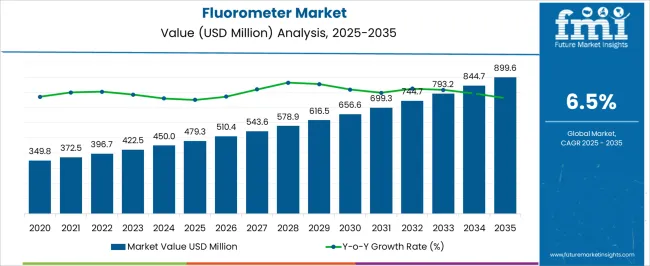
| Metric | Value |
|---|---|
| Fluorometer Market Estimated Value in (2025 E) | USD 479.3 million |
| Fluorometer Market Forecast Value in (2035 F) | USD 899.6 million |
| Forecast CAGR (2025 to 2035) | 6.5% |
The Fluorometer market is witnessing steady growth as advancements in analytical instrumentation and increasing research activities in life sciences and material science are driving demand. The current market scenario reflects a shift towards more sensitive and accurate detection technologies, which are essential in pharmaceutical research, environmental monitoring, and biochemical analysis. The future outlook is shaped by rising investments in R&D and expanding applications across healthcare and industrial sectors.
The growing need for high throughput screening and precise quantification of molecular interactions has encouraged the adoption of advanced fluorometric equipment. Furthermore, the integration of fluorometers with automated systems and data analysis platforms is enabling more efficient workflows in laboratories.
The market is also benefiting from increased focus on quality control in manufacturing processes and regulatory compliance in clinical settings As research initiatives continue to expand globally, the fluorometer market is expected to experience sustainable growth, supported by innovations in optical detection, user-friendly interfaces, and enhanced sensitivity that meet evolving customer needs.
The fluorometer market is segmented by application, equipment type, and geographic regions. By application, fluorometer market is divided into Chemistry, Biochemistry, Medical Research, Pharmaceuticals, Food Science, Environmental Studies, and Nanotechnology. In terms of equipment type, fluorometer market is classified into Spectrofluorometer, Filter Fluorometer, and Integrated Fluorometer. Regionally, the fluorometer industry is classified into North America, Latin America, Western Europe, Eastern Europe, Balkan & Baltic Countries, Russia & Belarus, Central Asia, East Asia, South Asia & Pacific, and the Middle East & Africa.
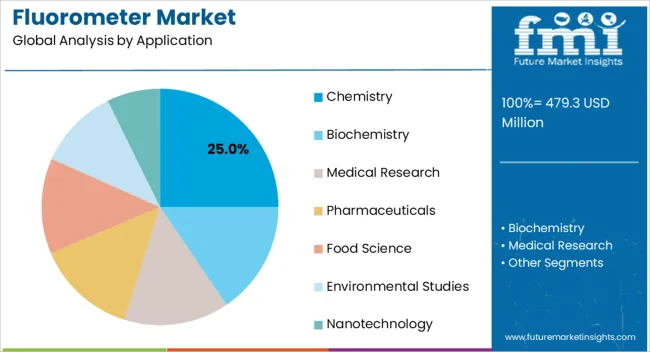
The chemistry application segment is expected to account for 25.00% of the Fluorometer market revenue in 2025, positioning it as a key application area. This growth has been attributed to the rising demand for precise molecular analysis and reaction monitoring in chemical research and development laboratories. The segment has been supported by increasing use of fluorometry in quantifying chemical compounds, analyzing reaction kinetics, and developing new materials.
The integration of fluorometers into analytical workflows has enabled improved accuracy and reproducibility, which are critical for chemical experiments. The segment’s growth has also been encouraged by the expansion of pharmaceutical manufacturing and quality control processes, where chemical analysis is essential.
Furthermore, the ease of integrating fluorometric techniques with other laboratory systems has allowed researchers to achieve better insights while reducing time and cost The demand for advanced equipment capable of detecting low-concentration analytes has further accelerated adoption, and continued technological developments are expected to strengthen the position of the chemistry application segment in the market.
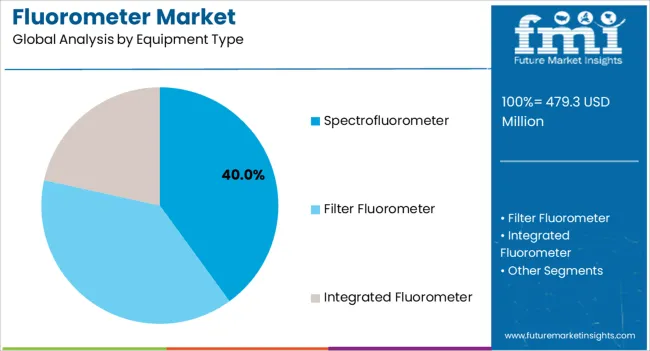
The spectrofluorometer equipment type segment is anticipated to hold 40.00% of the Fluorometer market revenue in 2025, making it the largest equipment type in the market. The prominence of this segment has been attributed to its superior sensitivity and versatility in fluorescence measurements across a wide range of samples. The segment’s growth has been driven by the expanding need for accurate and reproducible fluorescence analysis in pharmaceutical research, biotechnology, and environmental studies.
Spectrofluorometers offer the capability to measure excitation and emission spectra with high precision, making them ideal for complex molecular analyses. The ease of integrating spectrofluorometers into existing laboratory setups and automated systems has also supported adoption by improving workflow efficiency. Additionally, advancements in detector technologies and software-driven data interpretation have further enhanced the usability and performance of spectrofluorometers.
The segment’s strong presence is expected to be reinforced by increasing research budgets, stringent regulatory requirements, and the growing emphasis on high-quality data acquisition in laboratories Continued innovation and cost-effective solutions are likely to sustain the leading position of spectrofluorometers in the fluorometer market.
The flourishing biotechnological and pharmaceutical industries are raising a significant demand for laboratory equipment such as fluorometers, since the recent past. The increasing focus of enterprises on R&D and product innovation in biotechnology, food technology, and other similar sectors is resulting in increasing importance of fluorometer.
Manufacturers are adding technologically advanced fluorometers to their product portfolio, introducing through them the features such as optimized algorithm, and DNA or RNA degradation-based results, for a diverse range of fluorophore measurement.
These features of fluorometers are contributing significantly to a widening base of applications of fluorometers across different fields. Modern fluorometers are available in various formats such as compact form, benchtop models and large modular systems.
A fluorometer, also known as ‘fluorimeter’, is an instrument used for fluorescence detection that plays a vital role in the determination of the presence of specific molecules in a particular medium. Fluorometers are also used to measure fluorescent signals based on the wavelengths of excitation and emission from substances such as dyes, attached to biological molecules and also naturally fluorescent molecules.
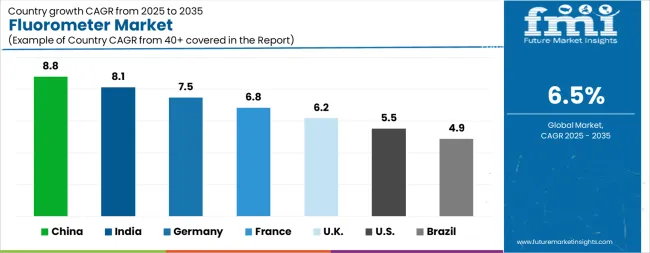
| Country | CAGR |
|---|---|
| China | 8.8% |
| India | 8.1% |
| Germany | 7.5% |
| France | 6.8% |
| UK | 6.2% |
| USA | 5.5% |
| Brazil | 4.9% |
The Fluorometer Market is expected to register a CAGR of 6.5% during the forecast period, exhibiting varied country level momentum. China leads with the highest CAGR of 8.8%, followed by India at 8.1%. Developed markets such as Germany, France, and the UK continue to expand steadily, while the USA is likely to grow at consistent rates. Brazil posts the lowest CAGR at 4.9%, yet still underscores a broadly positive trajectory for the global Fluorometer Market. In 2024, Germany held a dominant revenue in the Western Europe market and is expected to grow with a CAGR of 7.5%. The USA Fluorometer Market is estimated to be valued at USD 172.0 million in 2025 and is anticipated to reach a valuation of USD 294.5 million by 2035. Sales are projected to rise at a CAGR of 5.5% over the forecast period between 2025 and 2035. While Japan and South Korea markets are estimated to be valued at USD 22.9 million and USD 14.7 million respectively in 2025.
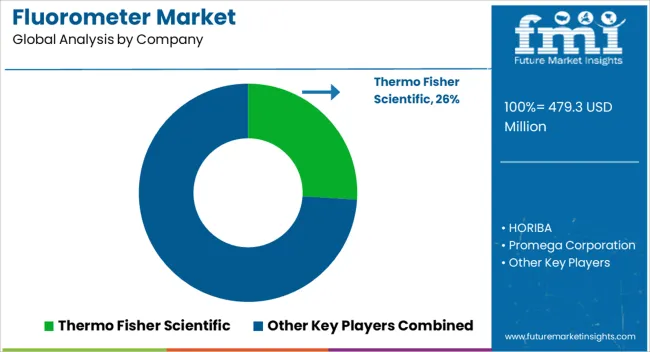
| Item | Value |
|---|---|
| Quantitative Units | USD 479.3 Million |
| Application | Chemistry, Biochemistry, Medical Research, Pharmaceuticals, Food Science, Environmental Studies, and Nanotechnology |
| Equipment Type | Spectrofluorometer, Filter Fluorometer, and Integrated Fluorometer |
| Regions Covered | North America, Europe, Asia-Pacific, Latin America, Middle East & Africa |
| Country Covered | United States, Canada, Germany, France, United Kingdom, China, Japan, India, Brazil, South Africa |
| Key Companies Profiled | Thermo Fisher Scientific, HORIBA, Promega Corporation, Bio-Rad, Photon Technology International, Turner Designs, Heinz Walz GmbH, Environmental & Scientific Instruments, Sea-Bird Coastal, and Bibby Scientific Limited |
The global fluorometer market is estimated to be valued at USD 479.3 million in 2025.
The market size for the fluorometer market is projected to reach USD 899.6 million by 2035.
The fluorometer market is expected to grow at a 6.5% CAGR between 2025 and 2035.
The key product types in fluorometer market are chemistry, biochemistry, medical research, pharmaceuticals, food science, environmental studies and nanotechnology.
In terms of equipment type, spectrofluorometer segment to command 40.0% share in the fluorometer market in 2025.






Our Research Products

The "Full Research Suite" delivers actionable market intel, deep dives on markets or technologies, so clients act faster, cut risk, and unlock growth.

The Leaderboard benchmarks and ranks top vendors, classifying them as Established Leaders, Leading Challengers, or Disruptors & Challengers.

Locates where complements amplify value and substitutes erode it, forecasting net impact by horizon

We deliver granular, decision-grade intel: market sizing, 5-year forecasts, pricing, adoption, usage, revenue, and operational KPIs—plus competitor tracking, regulation, and value chains—across 60 countries broadly.

Spot the shifts before they hit your P&L. We track inflection points, adoption curves, pricing moves, and ecosystem plays to show where demand is heading, why it is changing, and what to do next across high-growth markets and disruptive tech

Real-time reads of user behavior. We track shifting priorities, perceptions of today’s and next-gen services, and provider experience, then pace how fast tech moves from trial to adoption, blending buyer, consumer, and channel inputs with social signals (#WhySwitch, #UX).

Partner with our analyst team to build a custom report designed around your business priorities. From analysing market trends to assessing competitors or crafting bespoke datasets, we tailor insights to your needs.
Supplier Intelligence
Discovery & Profiling
Capacity & Footprint
Performance & Risk
Compliance & Governance
Commercial Readiness
Who Supplies Whom
Scorecards & Shortlists
Playbooks & Docs
Category Intelligence
Definition & Scope
Demand & Use Cases
Cost Drivers
Market Structure
Supply Chain Map
Trade & Policy
Operating Norms
Deliverables
Buyer Intelligence
Account Basics
Spend & Scope
Procurement Model
Vendor Requirements
Terms & Policies
Entry Strategy
Pain Points & Triggers
Outputs
Pricing Analysis
Benchmarks
Trends
Should-Cost
Indexation
Landed Cost
Commercial Terms
Deliverables
Brand Analysis
Positioning & Value Prop
Share & Presence
Customer Evidence
Go-to-Market
Digital & Reputation
Compliance & Trust
KPIs & Gaps
Outputs
Full Research Suite comprises of:
Market outlook & trends analysis
Interviews & case studies
Strategic recommendations
Vendor profiles & capabilities analysis
5-year forecasts
8 regions and 60+ country-level data splits
Market segment data splits
12 months of continuous data updates
DELIVERED AS:
PDF EXCEL ONLINE

Thank you!
You will receive an email from our Business Development Manager. Please be sure to check your SPAM/JUNK folder too.
Chat With
MaRIA